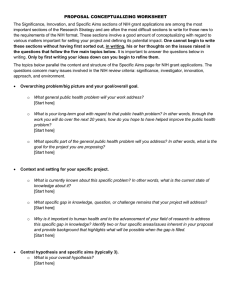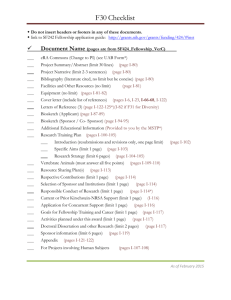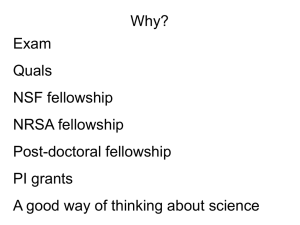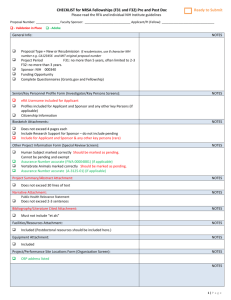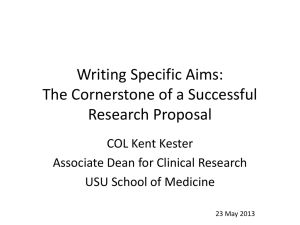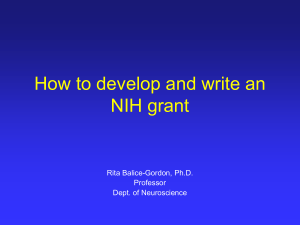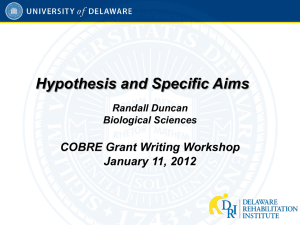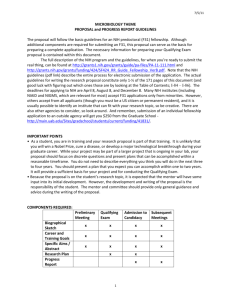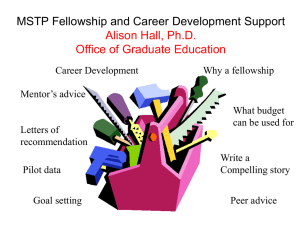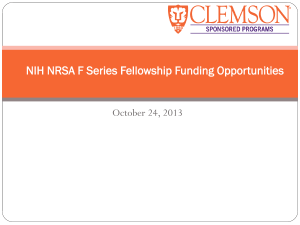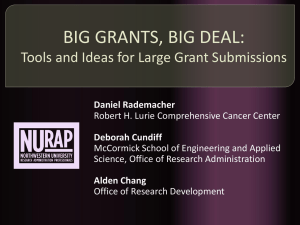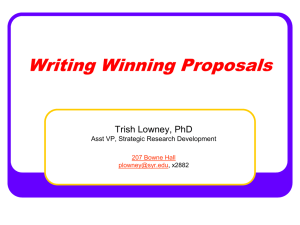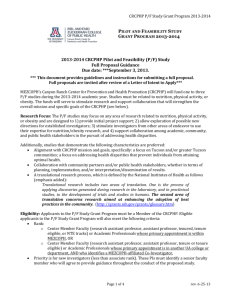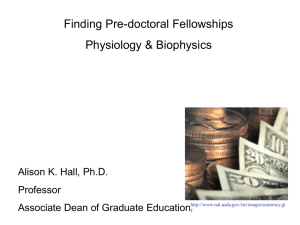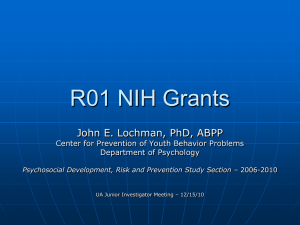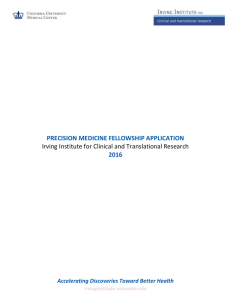Jameson-Fellowship Writing/Reviewers Perspective
advertisement
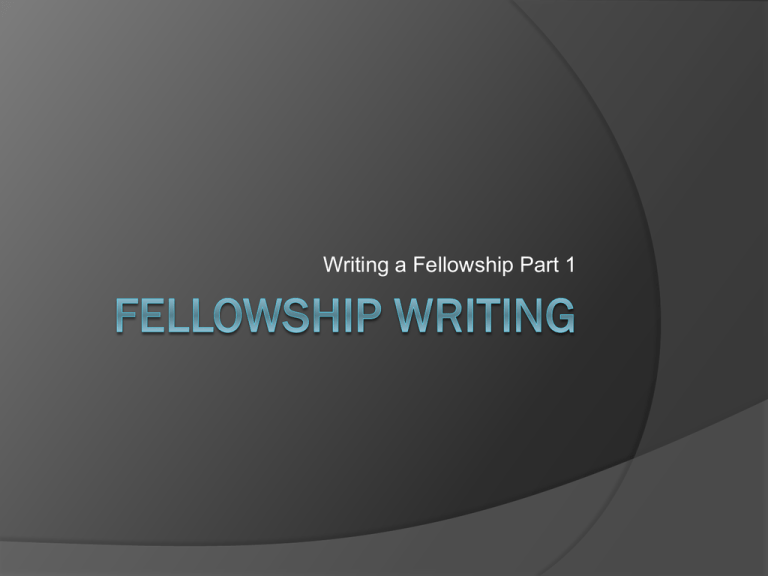
Writing a Fellowship Part 1 My Fellowship History In my third year as a post-doc fellow I received a Leukemia and Lymphoma fellowship for senior fellows meant to transition to faculty For two years I reviewed for the FO7 NIH Immunology (NRSA) fellowships F32, F31 Why write a fellowship? To practice and learn to write a grant For better job security To climb the academic ladder For a higher salary ($40,548 NRSA for 1st yr) Start Early Begin a folder of ideas Take notes at seminars Take time to read journal articles Overview of the common sections Research Strategy Sponsor and Institution Mentoring Plan Career Goals Letters of reference According to the NIH Promote Your Research Plan Your Research Plan may be the most important part of your fellowship application. Your plan must communicate: Clarity, completeness, and coherence. Originality, significance, and practicality of goals. A clear description of the research skills and knowledge you want to acquire, and your plan's potential for meeting these objectives. Potential of training to serve as a foundation for your health sciences career (for predoctoral investigators) or to advance your career as an independent researcher (for postdoctoral investigators). Plans to include a diverse human subjects population including women and minorities. Plans to include animals as test subjects, if applicable. Plans to obtain training in ethical research conduct. http://funding.niaid.nih.gov/researchfunding/traincareer/pages/advice.aspx#F2 Research Strategy- Specific Aims Start with generating your specific aims. If this section works well, it will set up your application and let the proposal fall into place. It must be logical and the aims must grow out of your central hypothesis Avoid “look and see” aims Eliminate extraneous detail (WHAT is being done) and supplement with why. Do not over propose, be realistic on your timeline Try not to let each aim be absolutely dependent on the previous one Example to start with: Aim #1 (use bold or italics) Working hypothesis Aim #2 (use bold or italics) Working hypothesis Possible to keep the aim general and the working hypothesis more specific. The Grant Application Writer’s workbook- NIH Research Strategy- Background Introductory paragraph/page needs to emphasize the relevance of the proposal to the interest of the institute (i.e. leukemia and lymphoma). What is the significance? Open with a sentence that makes clear how important this topic and your research on it would be. Then construct the “knowns” in the area followed by the “gaps” that need to be filled. Be direct and logical. Use transitions. If possible figure out who is reviewing the applications in order to determine the knowledge base of your reviewers. Research StrategyPreliminary data Important to show that you are already invested in this research and that you are able to perform some of the techniques you propose. If proposing a technique that is not done in the lab regularly then get a collaborator to write a letter. You can put the preliminary data in its own section or next to the section where you describe it in the research strategy section. Research StrategyResearch Plan Start with an outline and flow chart of the experiments that will be performed test your specific aim. For each Aim address: What will be done? What are the means used to accomplish the aim? What may go wrong? Alternative strategies to be used. Expected results (and why they are important) End each Aims section on a positive note (i.e. attaining the goal in this aim will allow…) Example outline for research plan: Specific Aim #1: title Introduction Experimental design ○ Study #1 (heading) ○ Study #2 (heading) Expected outcomes Anticipated problems/Alternative strategies The significance of completion of this aim Specific Aim #2: title Etc. The Grant Application Writer’s workbook- NIH Research Plan-Timetable future directions After the aims clearly state your timetable to show you can perform the studies in the time allocated. Be clear if you are doing certain experiments simultaneously or using mice for multiple aspects of the proposal. (Use chart or graph if complicated). Sum up where the project would be if completed as described. What would be the next steps in the study? Sponsor/Institute If your sponsor is a junior faculty member, get a co-mentor that can help out. Highlight the track record of your mentor/comentor in training and career development Be clear about what you will be learning from the mentor(s) Make sure the sponsor lays out a well detailed training plan! You can help them generate one specifically for YOU. Mentoring Plan Specifics: Site specific classes (with dates and title). Use SOF classes if at TSRI (like this one!) Identify specific meetings that you will be sent to and present at. Describe all of the lab meetings and journal clubs you will be participating in. Set primary goals (i.e. teach knowledge/techniques, strengthen experimental analysis, presenting skills, writing skills, teaching and managing skills, career development) Career Goals Be clear about your future plans and use the space to convince the reviewer that you will be a great new investigator in their field. They are looking for bright young scientists that want to work on their interests. Letters of reference Very important Use PIs that know you very well and understand your potential. Better to have a very descriptive and telling personal letter from a PI that knows you well, than a vague one from a famous scientist Get to know several PIs at the institute. Take your data to show them, get their opinion of your career plan. Collaborate to show your skills in the lab. Breathe a sigh of relief… and then get to work to get preliminary data for trying again next year!!
